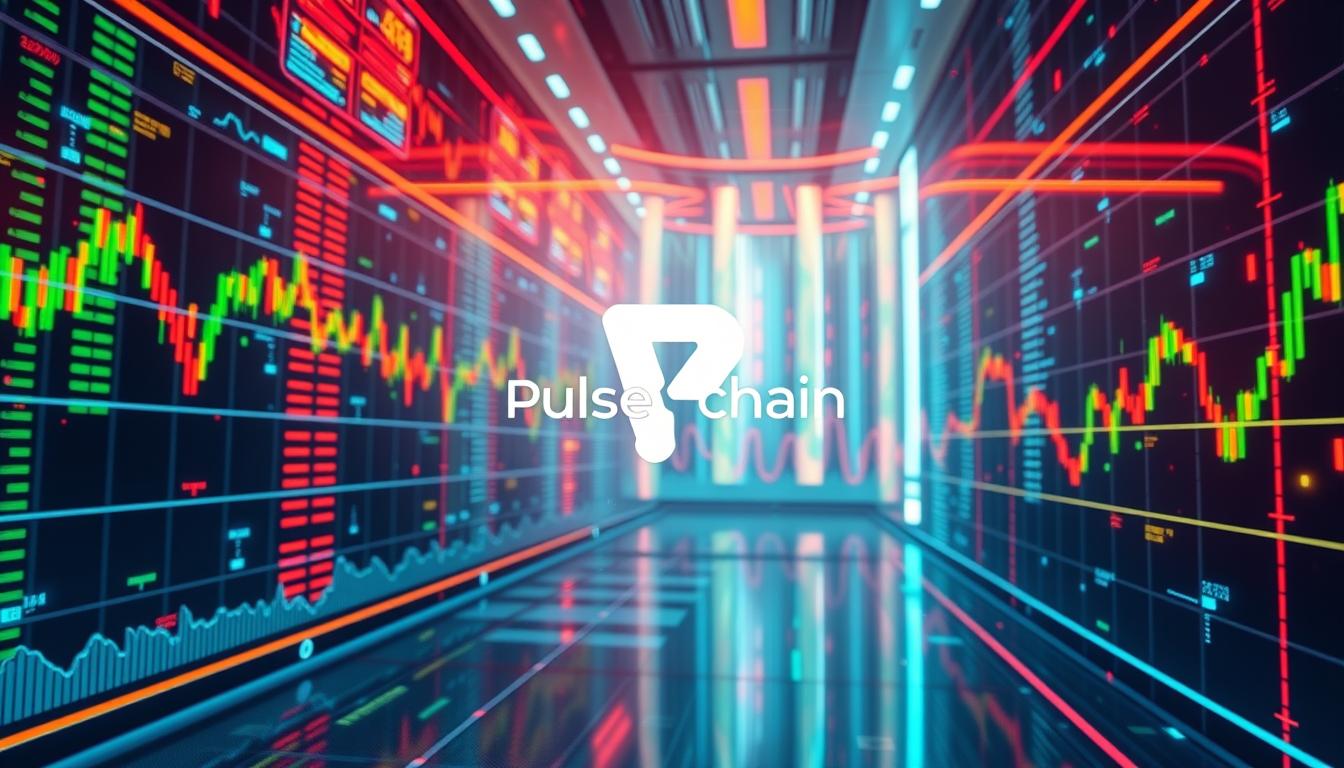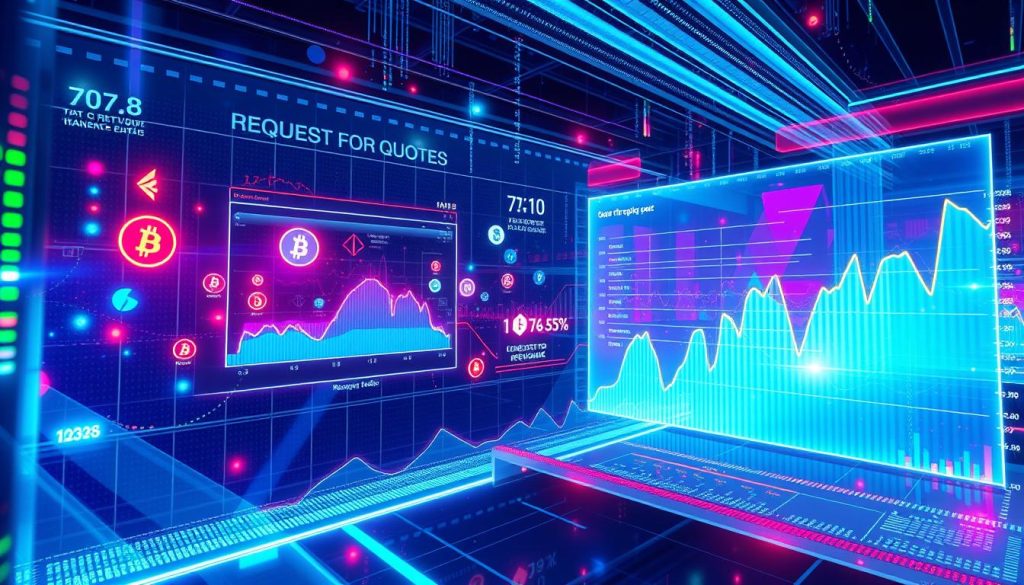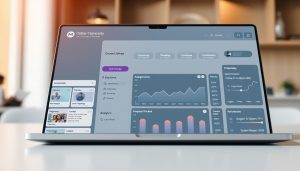Did you know Pulsechain has super fast block times, around three seconds? This makes it quicker than many blockchain networks. It’s interesting for those who keep an eye on cryptocurrency rates because Pulsechain changes a lot. This Ethereum fork uses a system called delegated proof of stake (DPoS). It makes the network handle more transactions and even burns some transaction fees. This helps keep the token’s value strong1.
It’s important for investors to know the current value of PLS. The market’s recent data shows how much PLS prices can move. For example, the highest price for Pulsechain this year was $4.41. It started at $3.98 and dropped to lows of $2.362. Pulsechain also plans to make fewer tokens. This could make them more valuable over time, which is good news for those thinking about long-term investments1.
Key Takeaways
- Pulsechain utilizes a delegated proof of stake (DPoS) mechanism, enhancing transaction speed and scalability1.
- The platform features a fee-burning mechanism to support token value over time1.
- Current market trends show Pulsechain’s highest price this year is $4.412.
- Pulsechain prices fluctuate, with lowest values going down to $2.36 this year2.
- Reducing token issuance aims to increase Pulsechain’s long-term value1.
Introduction to Pulsechain (PLS)
Pulsechain is a new layer-1 blockchain that changes the game by being a fork of Ethereum. It uses a unique system called delegated proof of stake (DPoS). This is different from Ethereum’s older proof-of-work (PoW) model3.
The brain behind Pulsechain is Richard Heart. This blockchain aims to reduce transaction costs, increase processing speed, and help make the token’s value go up over time with a special fee-burning feature3. Every transaction takes a bit of the token out of use forever, which makes the remaining ones more valuable1.
To keep things super secure, Pulsechain focuses on strong cryptography and regularly checks its code. Its DPoS system means transactions happen almost instantly, in about three seconds1. This not only makes using it better but also strengthens Pulsechain’s role in the crypto world1.
There’s a big plan for the largest airdrop ever with Pulsechain. It’s going to copy loads of Ethereum tokens and NFTs onto its platform, giving its users something extra1. It also says no to mining and excess token creation by using DPoS, making it greener1.
Pulsechain’s safety measures are top-notch, similar to the Cosmos Hub. It focuses on working smoothly with others in its family to bring down fees and improve Ethereum’s network too1. In just half a day after starting on May 13, 2023, 3 billion tokens were already burned. This shows Pulsechain is serious about its mission3.
Understanding the PLS Price Trends
Understanding Pulsechain’s price movement means knowing market forces and how people act in crypto. Pulsechain, born from Ethereum, uses a smart system to be a strong competitor4. It aims to reduce costs, make transactions faster, and be more scalable and green than Ethereum4
Pulsechain’s price jump is due to major network upgrades, making it faster and more scalable5. Investors are noticing and feel good about its future5. Decentralized finance (DeFi) and non-fungible tokens (NFTs) raise its demand, fitting right into PLS market moves5.
PLS is built on a proof-of-stake system for transactions, staking, and network decisions4. It draws in big and small investors. The DeFi boom and blockchain growth will likely push up Pulsechain prices into 20244.
To deal with price swings, investors should use several strategies4. Short-term traders can make the most out of price jumps but need to be wary of quick drops5. Long-term players bet on steady growth, pairing their money with tech success and wider use5.
Recent trends, like big companies investing in crypto and the generally positive vibe in the crypto world, help Pulsechain’s value5. Both newbies and veterans should research and keep up with PLS market changes to seize opportunities54.
Historical Data of PLS Prices
Looking into Pulsechain (PLS) price history is key for pros and new players. The way PLS acted over time shows important ups and downs.
Price Movement in the Year 2024
In 2024, PLS was really up and down. It started at $3.98, went up to $4.41, and dropped to $2.36, which means it fell by 27.64% by the end of the year6. In September, PLS’s top price was $0.00004302 on the 20th. Its lowest was $0.00003351 on the 12th6. Even with these ups and downs, its overall value stayed the same6.
Comparative Analysis with Previous Years
The year 2024 saw PLS’s value go up by 9.12% from 2023, showing how unpredictable crypto can be7. From April to September 2024, PLS’s price stayed within certain limits, hitting highs and lows of $0.000074 and $0.0000327. The biggest single-day jump happened on May 28, with prices moving from $0.000049 to $0.000055, which points out the huge daily shifts7.
Understanding these price trends helps investors foresee future changes. It lets them make smarter choices based on PLS’s past behavior7.
Key Factors Influencing PLS Price
Knowing what affects Pulsechain (PLS) prices is important for investors. The value of PLS depends on market forces and crypto tech advances.
Market Demand and Supply
The price of PLS relies on supply and demand. Currently, a PLS token is priced at $0.00003733828818996296. It has a circulating supply of 14.81 trillion PLS out of a maximum of 135 trillion PLS8. This large number available affects its price.
PLS increases supply through block rewards to validators8. Yet, some transaction fees are destroyed, reducing the total supply8. This helps keep supply and demand in balance, affecting PLS’s value.
Technological Advancements
Technology improvements also matter for PLS’s value. Better tech, like faster transactions from Pulsechain’s PoS model, makes it more appealing9.
These tech upgrades give PLS advantages like efficiency and speed. The network’s growth boosts Pulsechain’s usefulness, possibly raising its demand. Ongoing tech enhancements draw investors who prefer green solutions.
The mix of supply/demand and tech growth shapes PLS prices. Understanding these elements helps investors navigate the Pulsechain market.
Current PLS Pricing Options
When you put money into Pulsechain (PLS), you get to choose from different price options. This makes it easier to spread your investment across the crypto world. Each option’s price has two main parts: how much it’s worth now and how much it might be worth later10. The current worth depends on the option’s profit if sold today, while the future worth depends on how much the price might jump around and how long until you can sell it10
For a call option, its real worth is the stock price minus the call price10. If you’re looking at a put option, its real worth comes from the put price minus the stock price10. An option usually drops one third of its value in the first half of its life, and most of the rest in the second half. That’s why knowing when to buy or sell PLS is key.
Choosing where to trade PLS is a big deal. You need to look at fees, how easy it is to buy or sell, and what people think of the market. The option’s future worth is especially tricky because high ups and downs can change it a lot. It’s found by taking away the real worth from what you paid10. The Black-Scholes model is super helpful for figuring out these prices because it looks at all the important factors11.
To dive deeper into top options right now, check out strategies and models on leading platforms here. The Black-Scholes model, made in 1973, assumes markets move randomly and there’s no extra costs. It works best for European-style options with no dividends11. Knowing this can help you make smarter crypto investment choices.
Here’s a quick look at what impacts PLS prices according to the Black-Scholes model:
| Model Variables | Description | Impact on PLS Pricing |
|---|---|---|
| Strike Price | The set price at which the option can be bought or sold | Influences the option’s intrinsic value |
| Current Stock Price | The market price of the underlying asset | Affects both intrinsic and time value |
| Time to Expiration | Duration until the option expires | Longer duration increases time value |
| Risk-Free Rate | Interest rate considered free of risk, such as US Treasury bond rates | Used for discounting the expected option payoff |
| Volatility | The rate at which the price of the underlying asset fluctuates | Higher volatility leads to higher time value |
By knowing these details and how they work with the Black-Scholes model, you can better understand PLS costs. This model doesn’t just help with pricing. It also helps manage risks, improves portfolios, and makes markets work better11.
PLS Cost Estimation for Investors
For those planning to invest in Pulsechain (PLS), knowing about cost estimation is key. You need to consider things like transaction fees, how the market changes, and trends. It’s all about looking at past price patterns and future guesses, and understanding network changes that could affect costs.
Using strategies like break-even pricing can really help figure out where you make or lose money. Break-even price is where what you paid for something meets its selling price or fee12. For options trading, it’s where you can use a contract and not lose money12. Knowing this is valuable for making a strong Pulsechain investment plan.
Cost-plus pricing is another method to know about. This adds a set % on top of how much something costs to make, to find the selling price. Retail companies use this to keep price changes fair and get a steady profit13. For example, if jeans are priced at $82.50, this includes costs like materials ($10), work ($30), and overhead ($15) plus a 50% markup13. This approach is simple and adaptable, which is good in the unpredictable crypto market.
Understanding market conditions and what might happen next is vital too. Planning investments means looking at past info and future chances. Break-even pricing, often used by startups, helps get more customers by offering low prices without extra markup12.
Deep cost analysis also uses cost-plus pricing. By marking up the production cost, it finds a price that’s sustainable. This is easy to understand and justifies price changes13. Retailers like it for its predictable profit, which suits the uncertain world of crypto investments.
Let’s look at some data for comparison:
| Pricing Strategy | Definition | Advantages | Disadvantages |
|---|---|---|---|
| Break-Even Pricing | Price where cost equals sale value12 | Increases market share, stops new rivals12 | May lead to views of low quality12 |
| Cost-Plus Pricing | Adding a fixed percentage to unit cost13 | Easy, defends changes, steady profit13 | Risk of high pricing, may not cover all costs13 |
To wrap it up, using these points in your investment plan can really refine your Pulsechain strategy. Diverse cost estimating strategies help tackle market challenges, allowing for smarter financial moves.
For more details on smart pricing in crypto, check out investment planning here.
Market Outlook for Pulsechain (PLS)
The future of Pulsechain (PLS) looks bright, with experts expecting big gains. They predict that PulseChain’s current price of $0.00004374 could soar by 229.11% to $0.000135 by October 20, 202414. This prediction points to great earnings for those who invest.
Future Predictions and Analysis
Analysts see a wide price range for PLS in the future. They believe that by 2024, its price could swing from $0.000000426 to $0.000224815. By 2030, they expect even broader changes, from $0.000000896 to $0.000378115. This shows both the promise and the challenges of the market.
Impact of Market Trends
Market trends greatly affect Pulsechain. The push for decentralized finance and blockchain use helps raise PLS’s price. The current Fear & Greed Index is at 54 (Neutral) with market volatility at 6.64%, showing cautious optimism for PLS14. By 2040, the price of PulseChain might hit $0.001247, with a possible low of $0.0000998815, driven by these trends.
When thinking about investing, look closely at market forecasts and expert analyses. The right plan can turn predicted market moves into big wins.
How to Request a Quote for PLS
Requesting a quote for Pulsechain (PLS) cryptocurrency is done in steps. This ensures you get the right pricing information quickly. Follow these steps for an effective PLS rate request:
Start by finding trustworthy crypto exchanges or platforms that support Pulsechain (PLS). These platforms give current market data and tools to help with your quote. Using APIs or financial services for real-time PLS rates can better your investing or trading plans
Be clear when asking for a PLS rate quote. Mention how much PLS you want to buy and any time limits. Using a set process helps all businesses by making things clear and efficient16. For example, list what you need, with descriptions, how much, price per unit, and the total price. This keeps everything clear between you and the provider17.
It’s smart to ask detailed questions when getting a cryptocurrency quote. This helps pick the right vendors and makes sure you get quotes from those who really know their stuff. Making sure you know about payment methods, timelines, and special terms helps both sides understand costs and services16.
Using professional and clear emails for quotes is a good idea. These emails should ask for the price clearly, talk about any concerns, and include details or attachments. Making the message personal and setting a deadline helps make things go smoothly18. When you agree on the quote details, don’t change them unless both sides agree. This makes sure the agreement on service and price is solid17.
Lastly, using CPQ software makes quote creation and managing easier. This software works with CRM systems, handles pricing, and offers tailored reports. This makes the quoting process more effective and precise17.
By using these steps and tips, you can easily request a PLS rate and get accurate, detailed quotes for your cryptocurrency needs.
PLS Price List and Budget Proposal
Creating a detailed price listing for PLS helps investors understand the costs of getting and keeping this token. Knowing these costs is key for planning and managing your portfolio well. We will go into the pricing details and budget strategies for investors in the fast-changing crypto market.
Detailed Pricing Breakdown
Knowing the price listing for PLS well is important. Big projects need a clear budget breakdown. This includes both direct and indirect costs19. Direct costs can be things like salaries, tools, and travel. Overheads are covered by facilities and administrative (F&A) costs19. Also, federal contracts and grants have to follow Title 2 of the Code of Federal Regulations19.
For accurate proposals, price proposal templates for goods and services are key. The size of these templates varies. Product templates are 161 KB, and service templates are 181 KB20. Also, formats for commercial sales (27 KB) and subcontracting plans (211 KB) are crucial20.
Budget Strategies for Investors
Good PLS budgeting means knowing and managing risks. Currency changes can affect long-term deals and financial parts of partnerships19. Graduate student costs, like fees and tuition, should be separate from fringe benefits19. Plus, the University of California adds the Retirement Plan (UCRP) as a fringe benefit on non-federal awards19.
Using composite fringe benefit rates for budgets is also a smart move19. Make sure the direct costs make sense, are fair, and relate to the project directly19. Remember, fringe benefit rates can change, so plan for those future changes19.
In summary, a good price listing and smart investment strategies are key for budgeting with PLS. They help investors succeed in the ever-changing market.
Effective PLS Pricing Strategies
To create effective crypto pricing strategies for PLS, mix cost control with getting the most returns. This means knowing the market well, analyzing trends, and spreading your investments. Here’s a closer look at how to do this.
Cost Management Techniques
Managing costs well is key for good PLS pricing strategies. One way is value-based pricing, where you set prices based on what customers are ready to pay. This is like high-end watches selling at high prices21. Another way is cost-plus pricing, which adds your costs to desired profits when setting prices21. Since over 80% of buyers check prices before buying22, competitive pricing can help you keep or grow your market share21. These strategies help keep prices appealing, cover costs, and ensure you make money.
Maximizing Returns
Getting the most from your PLS investments needs a flexible, planned approach. Try dynamic pricing, which changes prices based on demand and supply, to increase earnings, like rideshare apps do21. Use penetration pricing to draw in customers with low prices at first, then raise prices once you’ve built a customer base21. To handle market ups and downs, averaging your investment costs over time can be smart. Also, learning from Amazon’s way of adjusting prices by keeping an eye on competitors can keep you competitive22.
Insights from Recent PLS Price Analysis
The latest analysis of PLS prices offers key insights into PulseChain’s market behavior. It shows PulseChain as a more deflationary choice than Ethereum due to its vast supply and lower issuance rate23. With 1.2 million times more supply than Ethereum, PulseChain offers lower costs and better access23. Its issuance rate is 15% lower, making its economy more deflationary23.
Using methods like the Exponential Moving Average and others helps predict PulseChain’s price movements23. Analysis of its price history shows significant ups and downs since its start23. These changes highlight why up-to-date PLS price information is crucial.
Expectations are high for PulseChain’s price in 2023, boosted by wider use and a positive market view23. The years 2024 to 2025 may see record peaks, driven by updates to the protocol and growing crypto investments23. This makes investing in Layer 1 blockchains like PulseChain an appealing option thanks to its strong price growth23.
A recent comparison highlights PulseChain’s performance against Ethereum and other blockchains23. This analysis provides investors with key insights into market trends and PulseChain’s growth potential23. Recognizing its volatility and the cyclical nature of the crypto market, which often follows four-year cycles, is essential23.
PLS’s use and recognition have surged in varied research fields since the early 2000s, despite some criticisms about biased estimates24. But these critiques have barely affected its application in marketing research24. This trend shows PLS’s established role in the sector.
PLS, created by Herman Wold, stands as an alternative to the classical LISREL approach, offering estimates in structural equation modeling24. Yet, using it carelessly, especially with latent variables, can lead to biases24. Grasping these details is key to effectively applying PLS.
In conclusion, keeping up with the latest PLS price analysis is essential for smart decisions on PulseChain investments. Properly understanding and applying these insights can improve your market strategies and investment outcomes.
Rate Inquiry Procedures for Pulsechain (PLS)
Understanding how to check PLS rates can boost your investment tactics. It’s vital for both experienced traders and new investors to get precise rate info. This guide will show you where to get reliable data and how to stay updated.
Where and How to Inquire
To get accurate PLS rate information, try major crypto exchanges like Binance and Kraken. They provide updated and detailed data on PLS. You can also look into financial news sites or crypto forums for discussions on Pulsechain. It’s important because the Pulse blockchain project, including HEX and PulseX tokens, has seen big price changes. For deeper insights, here’s a detailed article on Pulsechain’s challenges here25.
Reliable Sources for Rate Information
Trustworthy rate info comes from places like Bloomberg and Reuters, plus government-backed exchanges. These sources help you grasp PLS price moves. Note that Pulsechain PLS was traded on just two exchanges, at prices under $0.0002, with very high gas fees26. Using updated platforms prevents setbacks from old data.
In wrapping up, the best PLS rate checks come from timely and correct sources. Use different reliable sources for an advantage. This keeps you ahead in the fast-paced crypto market.









